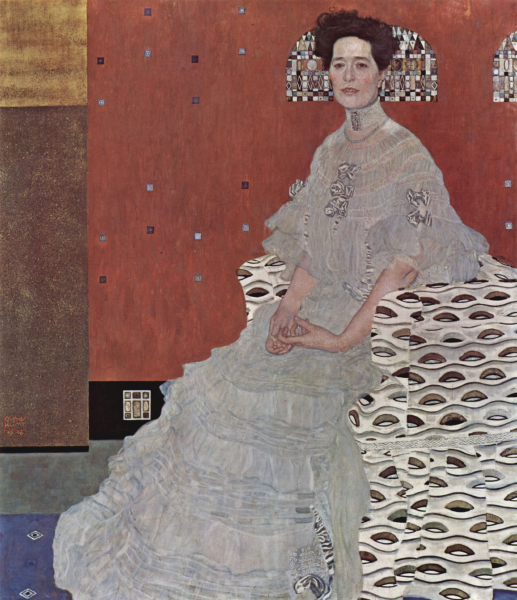Fritza Riedler
Gustav Klimt's portrait of Fritza Riedler from 1906 holds an unknown story behind the piece, as art critics and historians attempt to find the description behind the work. Nevertheless, the transitional artwork showcases the beauty of woman, alongside a style Klimt seized as a trademark.
The painting showcases a posed muse, with her head slightly tilted as she stares in the distance. The woman seems to be of Austrian decent, as Klimt's classic models were, with prominent Jewish features. Rosy cheeks highlight the woman's light skin, with dark arched eyebrows, and rich coloured hair placed in an up do. Klimt spent an ordeal of time figuring out a lip colour to use for his paintings, feeling as if it added another glimpse of colour to the piece. The colour used within the classic masterpiece is a light orange shade, naturally blending into the rest of the piece and not taking away any attention.
The woman is clothed in a luxurious white ruffled dress, drenched in layers of silk from neck to toe. The neck is position is a tight wrap of fabric, hugging the muse's shoulders. It continues in a minor white and grey fabric that flows into snow coloured ruffles at the sleeve. Silver coloured stones are placed in the middle of her chest, and on the sides of her sleeves showcasing a richer material. The rest of the dress flows in a white and grey coloured pattern towards the woman's feet. It is evident through the painting that the dress is made up of an array of layers, a precise detailed task Klimt achieved enduringly.
The artist favoured his muse to stand in an upright position in their portraits, as it showcases their dominance and illustrated their full body. The woman is slightly leans against a couch, yet reminds upright. The couch is drenched in a white and gold pattern, made up of swirls, curves and circles throughout the fabric. This design continues with Klimt's classic mosaic style as the pattern adds texture towards the piece and brings in the viewers attention. To accentuate the pattern without overpowering it, the background of the piece is illustrates in warm shades of orange.
The primary background piece is coloured in a bright orange, darkening towards the top of the wall. The artist had gone into a significant amount of detail by adding small squared boxes in a light pattern. Klimt changes the texture of the wall by adding two other colours to the left of the piece. A bright orange waved coloured area is added at the top left of the painting, paired with a bronzed textured area beneath it. The artist used a sponge technique to illustrate the bronze section, generating a rustic feel to the piece.
The woman's long ruffles dress is seated upon a lavender carpet, where a glimpse of lavender colour from her dress meets the floor. The masterpiece is a successful rendition of Klimt's art nouveau style, intertwining bright colours with bronzed materials paired with an array of patterns and textures.




